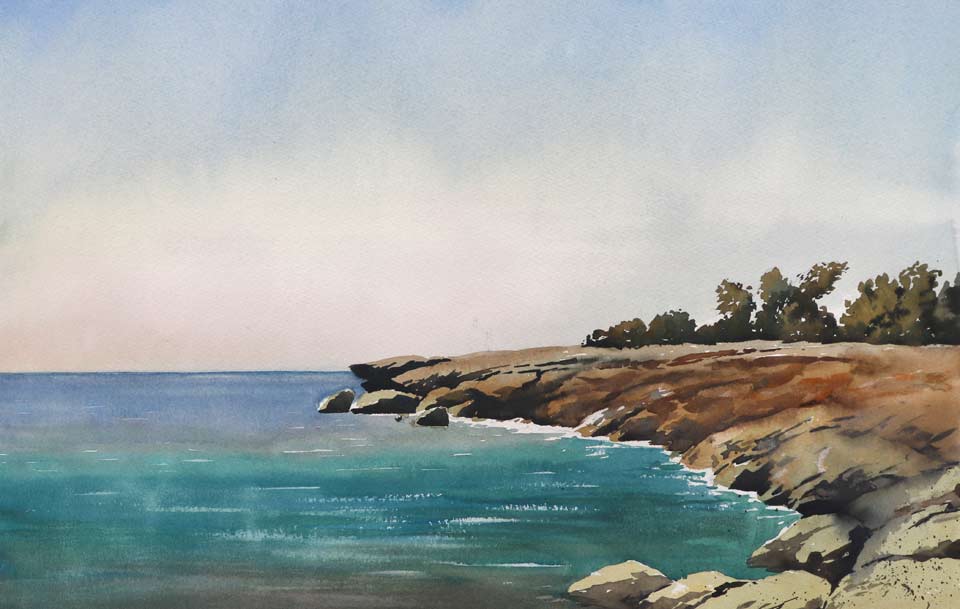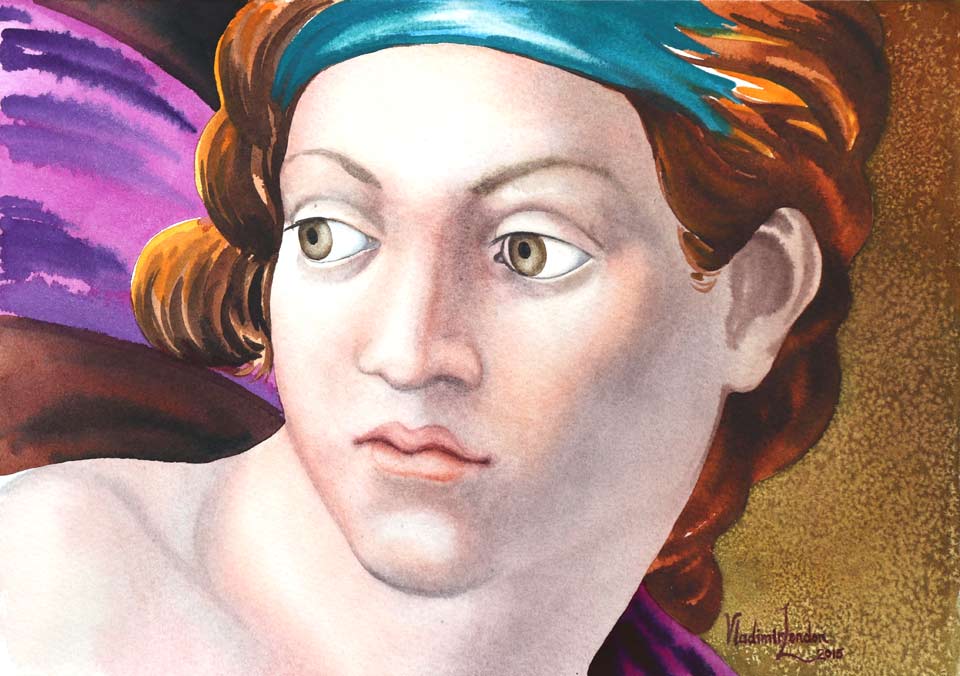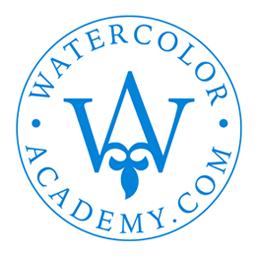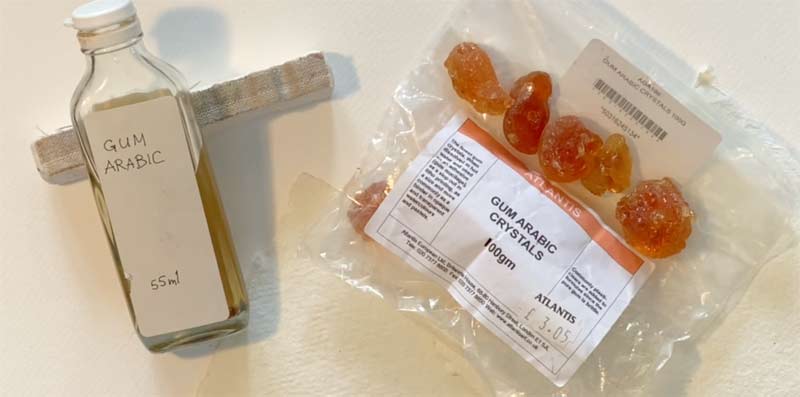Going Beyond Traditional Watercolor Painting Techniques
Article by Vladimir London, Watercolor Academy tutor
In addition to conventional painting techniques, I will also list some less mainstream ways of working in watercolor.

Sketch by Vladimir London, Watercolor Academy tutor
The methods you will read about below are totally optional and provided for information only.
If your goal is to become a skillful watercolor painter, you need to master traditional painting techniques first. They will serve you well in whatever style you decide to paint.
If you are a beginner, there is a danger of choosing a method from the list below and turning it into your main artistic style, thus limiting your creative possibilities.

Sketch by Vladimir London, Watercolor Academy tutor
With this disclaimer, we will explore some gimmicks and tricks that can be done in watercolor.
Sponge Wash
The name of this method gives a clue of what the wash is made with. Instead of using a brush, you paint with a sponge. Natural Greek sponges have an organic texture which can leave interesting imprints.
To do a wash with a sponge, it is loaded with pre-mixed paint and applied on the paper surface. By squeezing the sponge, you release more paint onto the paper. The same sponge can also absorb paint from the surface of an artwork.
Although this method can be very creative, overdoing it may turn a professional artwork into an arts-and-crafts project. I would suggest fully mastering the traditional methods of washes that are more proficient and controllable.
Using Body Colors
Tints in watercolor are achieved by diluting paint with water, not by adding white pigment. Nevertheless, Chinese White water-soluble paint is available in art shops and some artists mix it with watercolor paints. This, however, turns pure watercolor into a body color, similar to gouache.
Because watercolor paints become more opaque when mixed with white pigment, body-color can be painted over darker backgrounds and color layers of an artwork.
Depending on the amount of white paint added and water, this method can be described as, 'medium body color' or 'thick body color'. Thick body color has more white pigment (either Chinese White or tempera) and less water. It is more opaque than medium body color and can be mixed with a palette knife.
If you decide to use white paint, I suggest applying it on its own in only one or few small places, not mixing it with any other colors. This might work for highlights when the white paper was not preserved successfully.
Alternatively, these highlights can be achieved by scraping the painted surface with a scalpel or pencil knife to reveal the white paper underneath.
Using Gum Arabic
Gum arabic liquid is used to prolong drying time, but even more to intensify colors and prevent them going lighter when dry. It also improves covering properties.
Gum arabic should be added in a very small amount as it creates shine, makes paint surface brittle and also provides an environment for bacteria and mold to build up if a watercolor artwork is stored in a high humidity, warm climate.
Using Glycerin
Although some professional watercolor artists use glycerin in small amounts, it is not something you need to have in your toolbox. Adding glycerin to paint mix slows drying time and causes the paint to float above the water in washes. This makes it easier to move colors on paper and wipe them out if required.
Using Sea Salt
Sprinkling a painted surface while it's still wet with crystals of sea salt will give an interesting effect that looks like snowflakes. Dry salt absorbs water and paint, creating lighter spots in an artwork. It should only be wiped out after the surface is dry.

Sketch by Vladimir London, Watercolor Academy tutor
A similar effect of accidental lighter dots can be achieved by simply stippling a wet layer with clean water.
Using Charcoal
Making an under-drawing in charcoal and painting in watercolor on top is not recommended unless your creative task is to integrate black dust with your artwork.
An under-drawing in charcoal can be fixed on paper with a fixative, but it does not protect the charcoal drawing from smudging and diluting.
Continue the watercolor painting in much brighter and more pure tints on top, using a wide flat brush. Because the particles of charcoal are much bigger than those of the pigment, some additional binder might be required. You can add a little bit of gum arabic into the paint mixes in this case.
Using Drawing Inks
Some drawing inks are made of soluble dyes in a shellac solution. In liquid form, they can be mixed with water and can be used in watercolor artworks as separate washes, brushstrokes, or pen lines.
Shellac is water resistant, and so it is impossible to wash the ink out after it dries. I would suggest using cheaper synthetic brushes for inks and washing them thoroughly, immediately after the use. If the ink dries on the brush it will ruin it.
Layers of ink can be applied as an under-painting or on top of watercolor layers.
Making a grisaille under-painting in ink and then continuing with transparent glazing in watercolor is a popular technique for architectural drawings.
The use of watercolor and inks makes this application a mixed media technique.
Using Pastel
A combination of an under-painting in watercolor with drawing in pastel on a dry surface is another example of a mixed media technique.
Some artists make a preparation for pastel drawing in watercolor. Others use pastels to highlight places and add color and texture to an artwork.
Using Flour Paste
Using flour paste is a non-conventional method of watercolor painting. The flour is mixed with cooled boiled water and then the brush, loaded with paint, is dipped into the flour mix to apply the colors on paper. Alternatively, the whole surface of paper can be covered with the flour mix with a wide flat brush and watercolor painting continues on top.
The application of flour gives a different texture to paints and influences their flow.
Painting on Creased Paper
If you take relatively thin (180gsm or thinner) watercolor paper, smash it into a tight paper-ball, then unfold and soak it in water. It will return to its un-creased flat state. The fibers of the paper, however, will remember all the creases and take watercolor differently where the paper was folded, coloring all the lines of the folds deeper. This will create an interesting web of darker lines in the artwork.
This is just a gimmick, though it is an easy way of making an unpredictable decorative effect.
Masking and Pouring Paints
Instead of applying the paint with brushes, the artist can pour the paint on paper directly from mixing saucers or cans. Several (usually primary) colors are poured and intermix on the artwork's surface in almost accidental ways. Some extra colors can be introduced by dripping paint in. The puddle on the paper is then drained into a container.
This method is quite messy and unpredictable. To achieve recognizable realistic images, large areas of an artwork have to be preserved with masking fluid. The repetition of masking and pouring will produce sharp borders between washes and a chaotic fusion of colors within painted areas.
Although this technique is very limiting in the sense of traditional painting, some artists have turned it into their 'signature' style.
Spraying Paint Through Stencils
Using stencils to protect areas of an artwork from accidental splashes and dots of paint is a modification of the stippling technique. I don't see much point in stenciling because it is more arts-and-crafts than professional free-hand painting.
Washing Out Paint with Stencils
Plastic stencils can be used to protect the paper when washing out lines or shapes on a painted surface. Once again, it is better to use more traditional ways of protecting white paper than to perform craft tasks.
There are many other ways of having fun with watercolor and I'm sure that in the future amateur and professional artists and crafts-people will push the boundaries of painting techniques even further.
As I said before, you don't have to learn and use any of the techniques listed in this article.
To learn how to paint in watercolor, enroll now
Watercolor Academy Online Course
A self-study, self-paced course where you can learn how to paint in watercolor by watching video lessons and doing assignments
- Unlimited access to 80 watercolor painting video lessons
- Lifetime membership without deadlines
- Unlimited support from the Academy tutors
- Constructive critique of your artworks
- Member access to the Academy's Art community
- Place in the Academy's Students Gallery
- Exclusive members-only newsletter and bonuses
- Watercolor Academy Diploma of Excellence in your name
One-time payment - Lifetime membership
$297 USD
ENROLL NOW
Personal Tutoring online + Online Course
One-to-one, unlimited and custom-tailored to your skills and needs Personal Tutoring by the Watercolor Academy teachers
- Everything in Online Course, plus:
- Dedicated team of art tutors
- Assessment of your current level of art skills
- Personalized curriculum tailored to your skills and goals
- Up to 100 art tasks with by-task assessment
- Unlimited one-to-one personal coaching with detailed per-task instructions and feedback
- Artwork critiques and results-oriented guidance
One-time payment - Lifetime membership
$997 USD
ENROLL NOW









